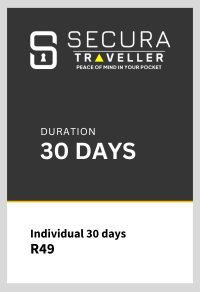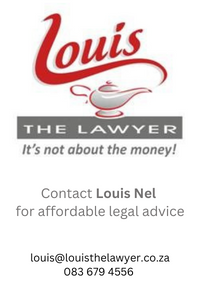louis-THE-lawyer: insert #5 - Copyright: Photographs
Copyright: Photographs - ‘A Picture Tells a Thousand Words’ …… Or Does It? – Rights & Obligations of The Subject (Part 1)
The tourism industry relies heavily on photographs to promote and sell its products and services. We all know the impact of a 4x2 metre picture of a white, sandy beach with swaying palm trees in a travel agent's window display on a passerby! Chances are you’ll make a sharp left into the shop, money or no money, and enquire about this destination.
As I always say: ‘There is the sexy stuff (as above) and then there is the not-so-sexy stuff, i.e. the legal issues such as T&Cs and copyright’. One of the ongoing challenges for the tourism and marketing fraternity is sourcing and using photographs and images without paying an arm and a leg. Conversely, there’s the photographer who more than likely makes a living from selling these photographs. I’ll deal with the former in this article and with the latter in my next insert.
So let’s start with one aspect of the ‘not-so-sexy stuff’ and discuss copyright. It is a form of intellectual property (‘IP’), the others being trademarks, designs, patents, and trade secrets. As with trademarks, you may acquire certain rights without registration, but unlike trademarks, there is no copyright register in South Africa.
As explained in my preceding inserts on my copyright series, copyright vests automatically the minute a concept (known in the case of photographs as ‘an artistic work’) is recorded in physical form.
However, if the photographer has been engaged and briefed to take the photograph(s) and paid for his/her efforts, the copyright will vest in the party who engaged him/her, UNLESS there is an agreement to the contrary. The same principle applies to an employee taking photos on behalf of his employer in the course and scope of his/her employment, subject to the terms and conditions of the employment contract – I am sure you are all aware of the Vodacom ‘Please call me’ saga.
There is a concept known as ‘fair use’, i.e. publishing images for purposes such as criticism, satire, news reporting, teaching, and research. Such applications do not require the permission of the photographer or the person whose image has been used, e.g., photographs of politicians.
Aspects that will determine whether the use of an image was fair include the following:
- Purpose: e.g., educational, non-profit
- Nature of use: e.g., public content
- Amount and substantiality used: e.g., a small piece of an image; thumbnail
- Market effect: i.e., you could not have purchased or licensed the copyrighted work
Commercial use is a totally different story, both as far as the photographer and the person whose image it is concerned. Such use includes, for example, selling it to a stock photo agency or creating an advertising campaign.
As far as the person whose image (including ‘identifiable facets of a person’s identity’) is concerned, it does not matter whether the photo was taken in a public space, even if the person is a celebrity.
Taking a photo of an individual gives rise to a number of issues:
- If the photograph is taken in a public space, the default situation is that you do not need permission.
- However, if there is any possibility of privacy, i.e., a question of whether the location is, in fact, public and one where privacy is expected or reasonably presumed, e.g., a private home, workplace, gym, or properties that are privately owned, such as casinos and shopping malls, it is a different scenario, and permission comes into the equation. However, the law is vague in this regard, and it seems that sun tanning on your Sea Point veranda is not quite the same as sitting in your dining room, sliding doors open with a vista of the sea.
- The latter is also linked to what is called ‘secret or covert photography’, i.e., when the individual is not aware of his/her photograph being taken.
Once taken, the next question is the use thereof – simply posting it on, e.g., Instagram is one thing, but, as mentioned, once commercial use is intended, despite the photographer owning the copyright, the permission of the subject comes into play and is advisable in order to avoid some of the issues mentioned above. Privacy protection includes any identifiable facet of your identity, and that includes your image. Distributing your image amounts to ‘processing’ as defined in terms of The Protection of Personal Information Act, Act #4/2013 (‘POPIA’). The latter also has special provisions pertaining to minors, and parental/guardian consent is required (More detail to follow).
There are, in addition, further requirements regarding the use of your image, i.e., the publication must not be used in a context that states or implies anything untoward, untrue about, or misrepresents you, as this may give rise to a libel action.
I will address more issues in the above vein in my next insert.
Aspects of the above are with acknowledgement of the following:
- https://www.rivaliq.com/blog/guide-copyright-fair-use-laws-online-images/
- https://www.news24.com/life/archive/birthday-parties-valid-consent-and-how-not-to-break-popia-law-20210729
© ADV LOUIS NEL
LOUIS-THE-LAWYER
AUGUST 19, 2024
DISCLAIMER - Each case depends on its own facts & merits - the above does not constitute advice - independent advice should be obtained in all instances.
LOUIS’ LEGAL ADVICE CLUB (‘LAC’) – Obtaining legal advice & guidance can be quite costly (See below*), hence my LAC via which you can obtain an hour’s legal advice for R750,00 per month once you’ve joined, AND the fee for additional hours is R1850 per hour! Furthermore, you are dealing with a lawyer who has been in tourism since 1982!
*The AVERAGE hourly rate is R2700 (https://www.myggsa.co.za/how-much-do-lawyers-charge-per-hour-in-south-africa/)























